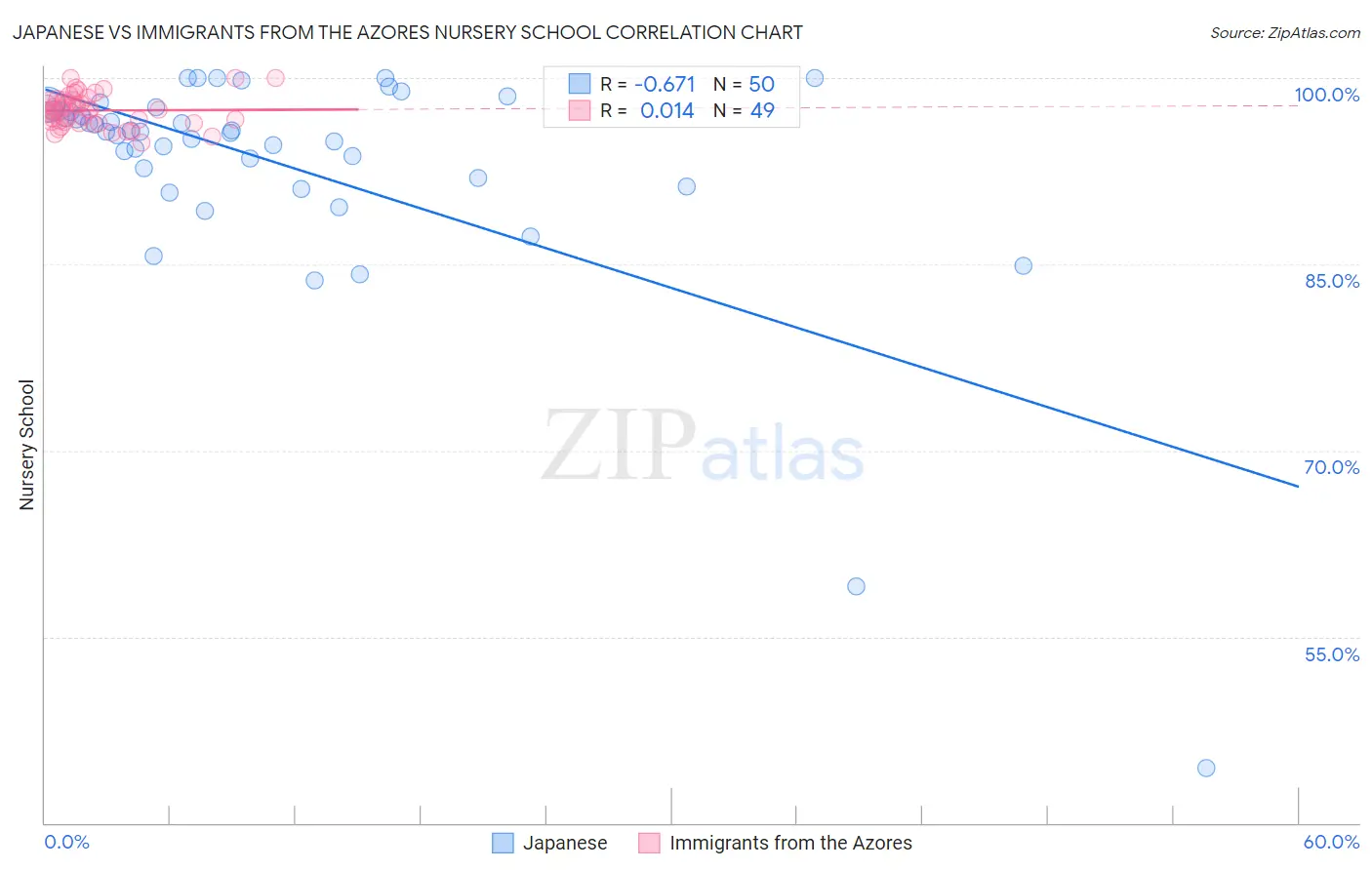Japanese vs Immigrants from the Azores Nursery School
COMPARE
Japanese
Immigrants from the Azores
Nursery School
Nursery School Comparison
Japanese
Immigrants from the Azores
96.7%
NURSERY SCHOOL
0.0/ 100
METRIC RATING
330th/ 347
METRIC RANK
97.0%
NURSERY SCHOOL
0.0/ 100
METRIC RATING
311th/ 347
METRIC RANK
Japanese vs Immigrants from the Azores Nursery School Correlation Chart
The statistical analysis conducted on geographies consisting of 249,183,224 people shows a significant negative correlation between the proportion of Japanese and percentage of population with at least nursery school education in the United States with a correlation coefficient (R) of -0.671 and weighted average of 96.7%. Similarly, the statistical analysis conducted on geographies consisting of 46,257,310 people shows no correlation between the proportion of Immigrants from the Azores and percentage of population with at least nursery school education in the United States with a correlation coefficient (R) of 0.014 and weighted average of 97.0%, a difference of 0.31%.

Nursery School Correlation Summary
| Measurement | Japanese | Immigrants from the Azores |
| Minimum | 44.4% | 94.8% |
| Maximum | 100.0% | 100.0% |
| Range | 55.6% | 5.2% |
| Mean | 93.0% | 97.4% |
| Median | 95.6% | 97.4% |
| Interquartile 25% (IQ1) | 92.0% | 96.4% |
| Interquartile 75% (IQ3) | 97.4% | 98.3% |
| Interquartile Range (IQR) | 5.4% | 1.9% |
| Standard Deviation (Sample) | 9.6% | 1.3% |
| Standard Deviation (Population) | 9.5% | 1.3% |
Demographics Similar to Japanese and Immigrants from the Azores by Nursery School
In terms of nursery school, the demographic groups most similar to Japanese are Immigrants from Vietnam (96.7%, a difference of 0.010%), Immigrants from Latin America (96.7%, a difference of 0.060%), Mexican (96.8%, a difference of 0.070%), Dominican (96.8%, a difference of 0.13%), and Indonesian (96.8%, a difference of 0.13%). Similarly, the demographic groups most similar to Immigrants from the Azores are Guyanese (97.0%, a difference of 0.0%), Sri Lankan (97.0%, a difference of 0.0%), Honduran (97.0%, a difference of 0.030%), Cape Verdean (97.0%, a difference of 0.030%), and Immigrants from Nicaragua (96.9%, a difference of 0.040%).
| Demographics | Rating | Rank | Nursery School |
| Guyanese | 0.0 /100 | #310 | Tragic 97.0% |
| Immigrants | Azores | 0.0 /100 | #311 | Tragic 97.0% |
| Sri Lankans | 0.0 /100 | #312 | Tragic 97.0% |
| Hondurans | 0.0 /100 | #313 | Tragic 97.0% |
| Cape Verdeans | 0.0 /100 | #314 | Tragic 97.0% |
| Immigrants | Nicaragua | 0.0 /100 | #315 | Tragic 96.9% |
| Immigrants | Belize | 0.0 /100 | #316 | Tragic 96.9% |
| Immigrants | Ecuador | 0.0 /100 | #317 | Tragic 96.9% |
| Immigrants | Guyana | 0.0 /100 | #318 | Tragic 96.9% |
| Immigrants | Laos | 0.0 /100 | #319 | Tragic 96.9% |
| Immigrants | Burma/Myanmar | 0.0 /100 | #320 | Tragic 96.9% |
| Immigrants | Bangladesh | 0.0 /100 | #321 | Tragic 96.9% |
| Mexican American Indians | 0.0 /100 | #322 | Tragic 96.9% |
| Immigrants | Honduras | 0.0 /100 | #323 | Tragic 96.9% |
| Vietnamese | 0.0 /100 | #324 | Tragic 96.8% |
| Dominicans | 0.0 /100 | #325 | Tragic 96.8% |
| Indonesians | 0.0 /100 | #326 | Tragic 96.8% |
| Mexicans | 0.0 /100 | #327 | Tragic 96.8% |
| Immigrants | Latin America | 0.0 /100 | #328 | Tragic 96.7% |
| Immigrants | Vietnam | 0.0 /100 | #329 | Tragic 96.7% |
| Japanese | 0.0 /100 | #330 | Tragic 96.7% |